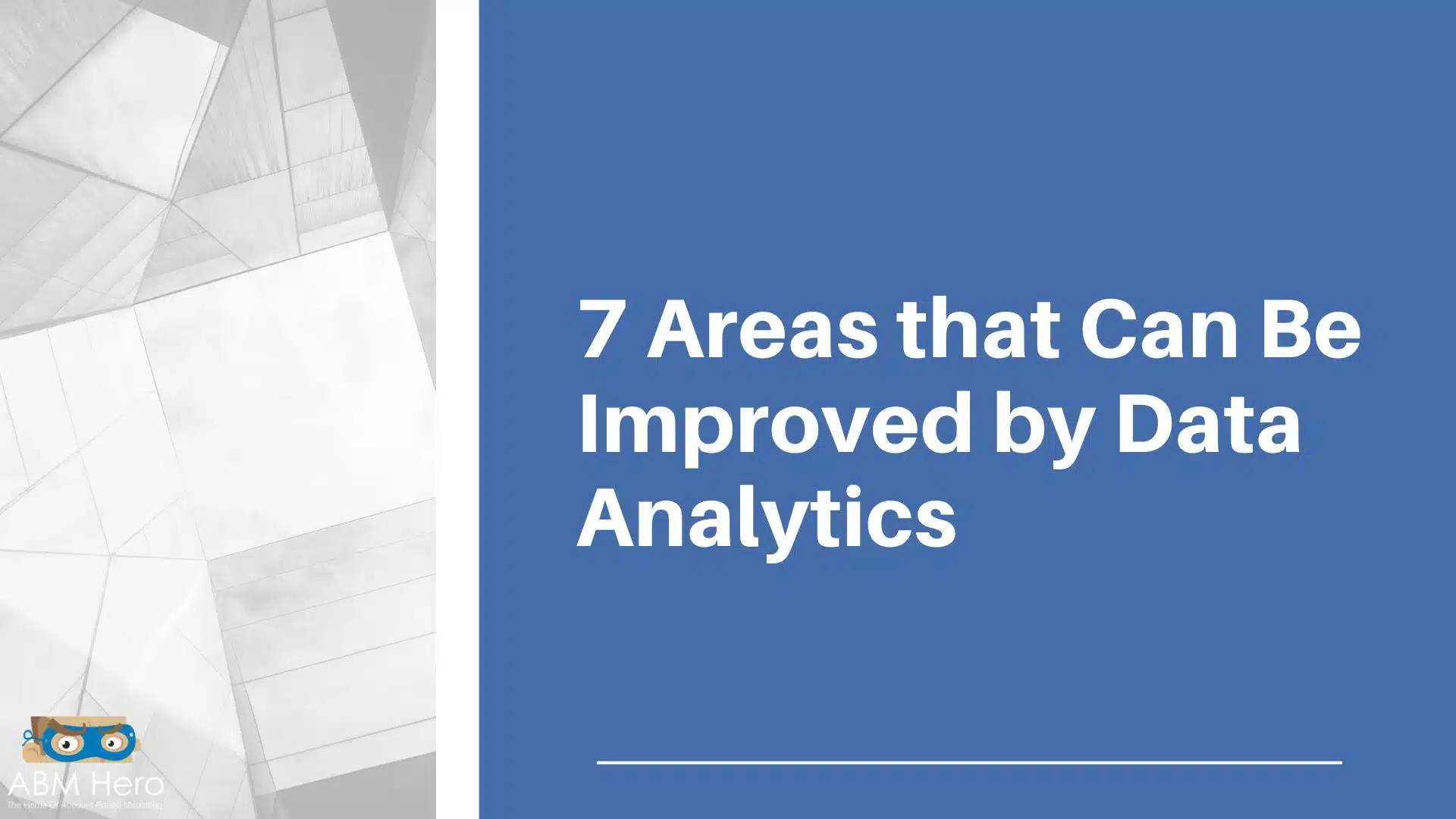Data analytics has become an invaluable tool in driving business decisions. It has enabled organizations to gain insights into customer behavior and trends, which can be put into practice to develop better strategies to optimize sales.
With its game-changing influence, data analytics is here to improve several areas in your B2B sales process. Businesses can optimize their sales process and increase their efficiency by leveraging data insights.
This article will discuss how data analytics is used to improve several areas in a B2B sales process.
How Marketers Perform Before the Boom of Data Analytics
Before the advent of data analytics, B2B companies relied on traditional sales processes to achieve their goals.
Generally, these processes involved salespeople identifying prospective customers and manually reaching out to them with offers.
It was a time-intensive process as salespeople had to sift through reams of information to find the right contacts and manually build relationships with customers to foster trust.
In addition, human bias often affects the effectiveness of the process.
Prospects were usually identified and selected based on the salesperson’s gut feeling and intuition, which could lead to ineffective targeting and wasted resources.
Furthermore, the sales process could have been faster and more efficient as salespeople had to manually keep track of leads and customer interactions.
With the rise of technology, countless efforts are introduced to streamline processes and amplify their marketing efforts at a reduced cost, and data analytics is one of those.
It has significantly helped marketers and decision-makers have a snapshot of their business activities and helped organizations break away from traditional marketing strategies and improve key areas within their processes.
These are the seven areas that can be improved with the help of data analytics:
- Customer Portfolio Optimization
- Product Portfolio Enhancement
- Sales Team Management
- Lead Prioritization
- Pricing
- Customer Relationship Management
- Customer Segmentation
Customer Portfolio Optimization
In ABM, the customer portfolio consists of the accounts targeted for marketing activities, and it is crucial to consider the composition of this portfolio to maximize the ABM program’s effectiveness.
The customer portfolio should be composed of accounts that are most likely to respond to the marketing messages and will be most profitable for the business in the long run.
Also, the customer portfolio should be segmented to determine which accounts are most likely to purchase specific products or services, allowing for more efficient and effective targeting of marketing messages.
Data analytics has revolutionized the way that marketers optimize their customer portfolios. By utilizing sophisticated software tools, marketers can analyze vast amounts of customer data to uncover patterns, trends, and insights that can be used to inform marketing strategies.
Through data analytics, marketers can better understand customer needs, desires, and preferences, enabling them to develop more effective customer segmentation strategies and tailor marketing campaigns to specific customer segments.
It can also be used to gain insights into customer behavior and identify opportunities to improve customer service and marketing tactics.
Furthermore, data analytics can help marketers measure the success of their efforts, enabling them to refine and optimize their strategies and target specific customers with tailored messages.
Product Portfolio Enhancement
In account-based marketing (ABM), a product portfolio refers to the full range of products and services offered to a particular customer or group.
It’s a comprehensive overview of what a company offers and can be seen as a critical part of account-based marketing. From a business perspective, the product portfolio is essential for understanding the complexities of customer relationships, as it allows for more precise segmentation of customer groups and allows businesses to tailor their offering to meet the needs of particular customers.
On a more strategic level, the product portfolio can be used to identify opportunities for product differentiation and expansion, allowing companies to leverage their competitive advantage in the market.
By leveraging the power of data analytics, B2B companies can identify and capitalize on new opportunities, optimize their existing products and services, and gain valuable insights into customer behaviors and preferences.
Through data analytics, B2B companies can better understand their customer base, allowing them to tailor their offerings to suit their needs better.
Additionally, data analytics can enable B2B companies to gain a competitive edge by allowing them to identify trends and patterns in the market and develop strategies to capitalize on them.
Sales Team Management
An integrated data analytics system can be invaluable to any B2B organization looking to mobilize its sales team.
By collecting, organizing, and analyzing data from a variety of sources, such as customer records, market trends, and industry insights, an integrated data analytics system can provide invaluable insight into the current state of the organization, giving the sales team the information they need to make informed decisions.
This system can also provide predictive analytics that allows the sales team to identify emerging trends, recognize customer needs, and anticipate future market conditions, giving them a better understanding of their customers and the marketplace.
Additionally, an integrated data analytics system can provide the sales team with a better understanding of their current performance, allowing them to identify areas where they can improve and address them effectively.
Lead Prioritization
In terms of B2B companies driven by data analytics, it is essential to focus on lead prioritization strategies to maximize success.
Data analytics allows companies to collect and analyze data from customer interactions, providing a clearer picture of customer activity and preferences.
It can be used to improve lead prioritization strategies in several ways.
Data analytics can identify trends in customer behavior that can be utilized to prioritize leads.
For example, data can be analyzed to identify potential customers who are in the early stages of the buying cycle and may be more likely to convert.
Also, data analytics can be used to identify high-value leads and prioritize them accordingly.
By understanding customer preferences, companies can prioritize leads based on their potential to provide the most value to their preferred customers.
Pricing
When setting the price of products and services within a B2B organization, the need for more data analytics can make the process significantly more difficult.
Without the insights from data analytics, the organization is left with only basic assumptions about the market, industry, and customer base.
It can lead to irrational decision-making and mistakes in pricing that could have a long-term negative impact on the organization’s profit margins.
Furthermore, with data analytics, it can be easier to identify trends in the market or customer behavior that could be used to inform pricing decisions.
With the ability to accurately identify and respond to these trends, organizations may be able to maximize their profits or maintain a competitive edge.
Customer Relationship Management
A well-crafted data analytics system can have a substantial positive impact on customer relationship management (CRM).
Through data analytics, companies can gain valuable insights into their customers’ behavior.
It allows them to personalize their customer service, customize their marketing campaigns, and develop better products and services.
Data analytics also aids in the understanding of customer preferences, which can be used to create targeted campaigns that are more likely to result in higher customer satisfaction and loyalty.
Besides, data analytics can help identify customer trends in the market, providing valuable information to guide strategic decisions.
By leveraging data analytics to gain a deeper understanding of customer behaviors and preferences, businesses can more effectively engage with their customers and build stronger customer relationships.
Customer Segmentation
A sound data analytics system can drastically improve customer segmentation by giving organizations a deeper understanding of their customer base.
By leveraging the available data, such a system can provide insights that may not have been previously known or visible to the organization.
Through the use of advanced analytics and data mining techniques, a data analytics system can provide organizations with actionable insights into customer segmentation.
For example, an analytics system can provide a more detailed view of customer behavior, allowing organizations to segment customers further based on their preferences and behaviors.
It can allow organizations to create more targeted marketing campaigns and tailor their services to fit their customer segments better.
Likewise, a data analytics system can provide organizations with deeper insights into customer loyalty, which can be of use to refine their customer profile further.
As a final point, data analytics has already become an integral part of business as it offers a range of tools that can be utilized to understand customer behavior better and improve several areas in your sales process.
Through data analytics, organizations can achieve more significant insights into customer needs and preferences, helping them tailor their services to fit those needs and drive better customer experience.
By leveraging the power of data analytics, businesses can reduce operational costs and increase profits.
Eventually, data analytics helps businesses make more intelligent decisions to benefit the customers and the business itself.





